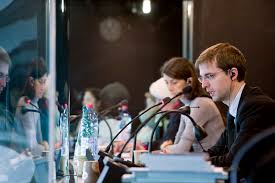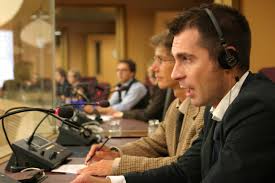Interpretación Simultanea
Language interpretation, or simply interpretation, is the linguistic mediation activity that consists of transmitting an oral or sign language speech, giving rise to an equivalent speech in a different language, either oral or sign language. The resulting product of said activity is also called interpretation.

By Isaac Barón
June 7, 2021

Simultaneous Interpreting
Simultaneous translation or simultaneous interpretation, as it is known now, is perhaps the most common, perhaps because it is the subject of several Hollywood films, such as The Interpreter.
In simultaneous interpretation, one or more lecturers speak in their native language to the audience and two or more interpreters translate so that the audience can hear the speech in their own language, through their radio receiver and headphones.
Generally, the interpreters are in separate booths from the room and receive the audio of the conference and then simultaneously interpret and broadcast this audio to the participants in the room through FM or infrared receivers.

In simultaneous translation or interpretation the lecturer does not need to stop for the interpreter to translate. The interpreter is translating at the same time that the lecturer is speaking.
As you can imagine, this is a very strenuous job that requires maximum concentration. Therefore, interpreters can only translate for a maximum period of 20 or 30 minutes per shift. That is why it is necessary to have two interpreters in the booth to take turns and relieve the partner. Obviously, this is done for the sanity of the interpreter but also for fluency for the audience. Because if the change were not made, it is very likely that the translation would start to fail after 20 or 30 minutes of continuous work. There would begin to be semantic, content and form errors.
Simultaneous translation is very useful because the speaker’s message is transmitted to the room with the same intention, the same vocabulary, register and tone, only in the target language of the venue.
Nowadays, simultaneous interpretation is being used more and more, but without the need to have the interpreters physically present in the same room. Interpreters can work from the comfort of their home or office sending the audio signal not only to the room but to any participant who requires it and anywhere in the world.
Similarly, simultaneous interpretation is being used for small meetings, boards of directors, business affairs, presentations, and more. With the arrival of the COVID-19 coronavirus, it has been seen that remote meetings are not only a cheaper, but are a must. Because the obligation to transport senior executives is avoided with the risk that this implies and the carbon footprint left when using transportation by air and land. Likewise, this mode of remote meetings reduces costs substantially. For example, in the area of translation or interpretation, they are up to 50% cheaper.
Simultaneous interpretation or translation is a highly specialized and highly paid service in all parts of the world. As long as there are different languages, there will be a need to interpret human speech. So far, computers, artificial intelligence and current algorithms are not capable of doing this. It is necessary to employ the human mind with its hierarchy of thought to be able to analyze, interpret and pronounce the spoken speech with accuracy, exact register, and proper intention of the lecturer. In text translation, machine translation or machine translation algorithms have made a lot of progress and can translate very quickly into 26 or more languages, but only typed or written text. Spoken speech would require recognition by the computer and simultaneously issue a reproduction of any segments of meaning enunciated to be understood as natural speech and this has not yet been perfected. For now, we must assign this task solely to the power of the human mind with professional specialists in interpretation.



